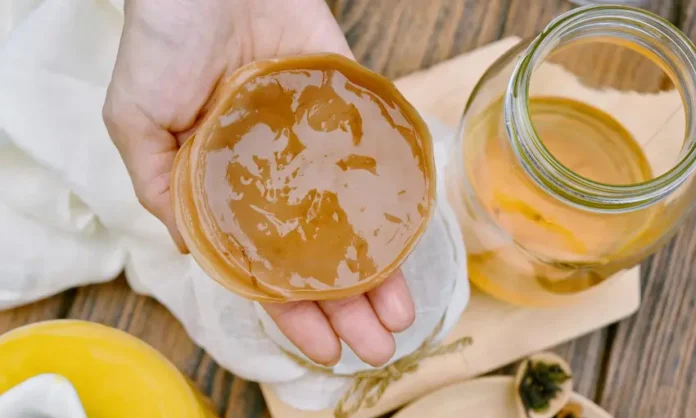Kombucha tea is a fermented beverage crafted from botanical tea and a foundational culture known as “kombucha scoby” (symbiosis of yeast and bacteria). This fundamental culture, recognized as the “kombucha mushroom“, appears as a thin, jelly-like layer that ferments botanical tea, transforming it into the enchanting elixir, kombucha.
The kombucha fermentation process involves combining sugar with botanical tea in a jar and adding the kombucha starter. This culture then consumes the sugar in the tea, yielding various acids, enzymes, probiotics, and vitamins. The duration of this process varies, ranging from several days to a few weeks, depending on fermentation preferences and desired flavor profiles.
Kombucha is renowned for its subtly tangy taste, coupled with a gentle carbonation emerging during fermentation. Additionally, it’s often infused with fruits or medicinal herbs to achieve a more diverse flavor palette. Beyond its refreshing taste, many individuals relish kombucha for its potential health benefits. Stay tuned to discover the medicinal properties of kombucha tea.
Kombucha benefits
Kombucha enjoys global recognition under various aliases, also tea mushroom, tea fungus, or Manchurian mushroom. although it dominates as kombucha tea, some refer to it as the longevity mushroom due to its numerous medicinal properties that aid in revitalizing the entire body.
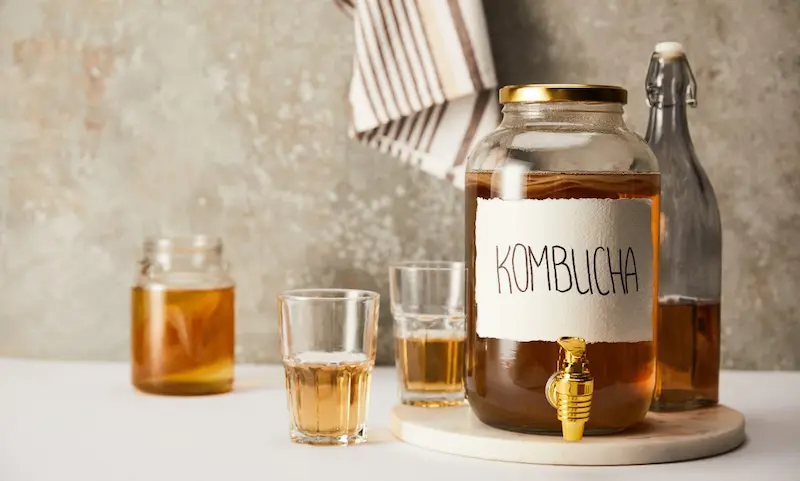
According to ancient beliefs, kombucha tea rejuvenates the body, preventing wrinkles and serving as an exceptional immune booster. During fermentation, the kombucha mushroom generates lactic, acetic, and glucuronic acids, contributing to the formation of several vital polysaccharides.
Hyaluronic acid is essential for connective tissue, chondroitin sulfate is foundational for our cartilage, while mucoidin sulfate is crucial for mucus and the vitreous body of the eye. Lactic acid proves highly beneficial for the colon. Additionally, it’s rich in vitamins and enzymes, functioning as a natural antibiotic.
Kombucha tea lowers blood pressure and stimulates gland function. Boost immunity, aiding in fat burning, consequently reducing body weight. It reduces urea, sugar, and cholesterol levels in the blood, assisting with rheumatic and arthritic discomforts by enhancing joint mobility and spinal elasticity. It also aids in irregularities in stomach, liver, and kidney function, as well as bone pain, arteriosclerosis, and skin conditions. Restoring intestinal flora helps alleviate constipation.
The kombucha mushroom, or the tea derived from it, assists asthmatics and those with bronchitis by alleviating symptoms like persistent coughing. It promotes bile function and natural gallbladder emptying. Moreover, it aids in ulcerative colitis, swiftly halting prolonged and persistent diarrhea almost instantly.
Kombucha recipe
Before delving into the detailed process of creating a kombucha mushroom, let’s outline a few tips and unwritten guidelines crucial for achieving a perfectly delightful kombucha tea. Prepare the kombucha mushroom in a solution of botanical tea; if you’re not fond of black or green tea, opt for any other herbal tea that suits your taste.
While we’ll provide measurements for preparing one liter of kombucha tea later in the article, it’s preferable to brew a larger quantity to ensure a week’s supply. When initially crafting kombucha tea with a dry starter, add one tablespoon of apple cider vinegar per liter of tea to expedite and enhance fermentation.
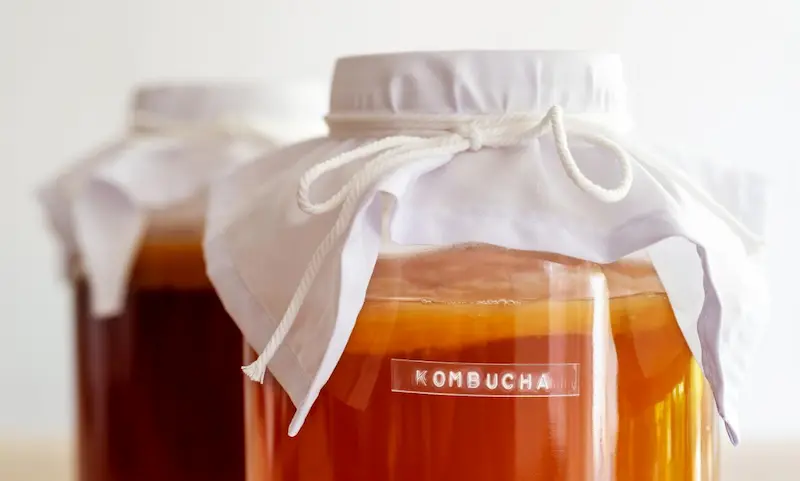
The kombucha mushroom starter can be acquired in dried form from health food stores, occasionally even in liquid form. Should you be fortunate enough to find a liquid form of the kombucha starter, utilize the tea received alongside the mushroom instead of apple cider vinegar? This occurrence commonly arises when encountering a donor who brews the kombucha mushroom at home.
Where to buy kombucha mushroom?
To commence crafting kombucha tea, acquiring a kombucha mushroom, or the starter for its cultivation, is essential. Wondering where to buy a kombucha mushroom or how to obtain one? You can procure the starter at most well-stocked health food stores, primarily in a dried state.
However, many individuals cultivate kombucha mushrooms at home and are often willing to share a bit of tea and the kombucha starter with you, allowing you to initiate your cultivation. Of course, this is feasible if physically viable. Thus, numerous social media groups exist where you can find the starter in your vicinity.
Feel free to inquire in the comments section below, whether seeking or offering a kombucha mushroom. Now that you have your kombucha mushroom or starter, we can begin the preparation process.
How to Make Kombucha Mushroom?
Prepare the herbal tea conventionally: for one liter of boiling water, add two teaspoons of black or green tea. Alternatively, you can use tea bags—replace the two teaspoons with two tea bags. For the magical kombucha elixir, green tea is recommended, but any other herbal tea to your liking can be used. Allow it to steep for around 15 minutes.
Strain, Sweeten, and Cool the Tea
Once steeped, strain it through a sieve or cotton cloth to remove any particles or plant residues. Then, add 100 grams of white refined sugar to one liter of tea before it cools to aid easier dissolution. To continue the process, cool the tea until lukewarm, ideally between 20°C and 25°C. Keep in mind that the culture perishes if placed in overly hot tea.
What Container Should Be Used for Kombucha Mushroom?
For fermenting kombucha tea, a glass vessel is preferred. Initially, you can prepare it in a smaller jar of up to one liter. However, if you plan to consume the magical kombucha elixir daily, you’ll need a container of at least five liters. Porcelain, glazed clay, or stainless steel containers can also be used. Non-stainless steel metal containers aren’t suitable due to potential acid reactions.
Should I Add Apple Cider Vinegar?
When preparing the magical kombucha elixir for the first time with a dry starter from a health food store, it’s beneficial to add a tablespoon of apple cider vinegar to one liter of herbal tea. This accelerates and enhances the fermentation process. However, if you obtained the starter in a tea form from a donor, simply add the tea in which the starter was. Remember, always reserve enough liquid (1:10) for the next kombucha preparation.
How to Create the Kombucha Mushroom?
Once your tea and starter are ready, and you’ve chosen your fermentation vessel, pour the prepared herbal tea and the starter liquid into the selected container, as explained in the previous steps. Then, add the live culture of the kombucha mushroom to the vessel.
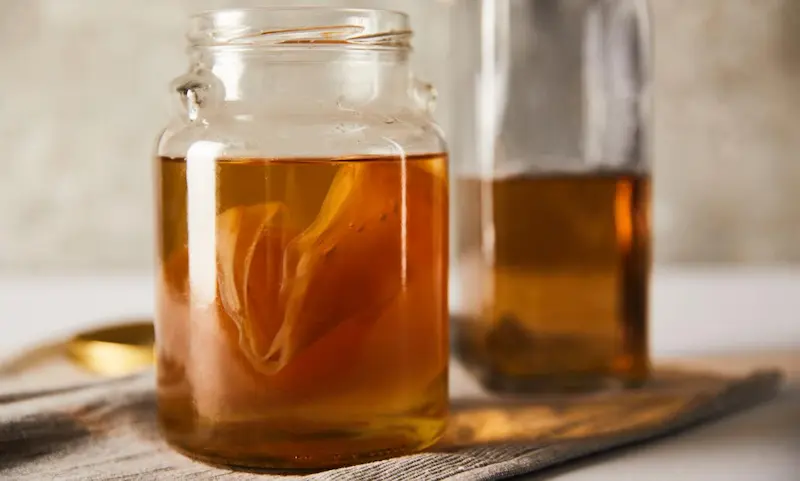
How to Protect and Preserve the Mushroom During Fermentation?
After adding all necessary ingredients, preserving the kombucha mushroom requires covering the container with a cotton or linen cloth and securing it with a rubber band. This safeguards the elixir from fruit flies, dust, plant spores, and other contaminants. The fabric must be porous enough to allow air circulation for the culture to breathe, yet not so much that tiny insects can enter.
The Kombucha Mushroom Fermentation Process
Fermentation typically lasts between 8 and 12 days, depending largely on the fermentation temperature. Higher room temperatures expedite fermentation. The tea temperature should not drop below 20°C nor rise above 30°C, with the ideal temperature being 23°C. Kombucha requires a dark, warm, and tranquil environment. Once fermentation begins, refrain from moving or agitating it until the fermentation process concludes. It’s crucial to note that exposing the culture to intense sunlight can be detrimental.
During fermentation, yeast breaks down sugar into gas (CO2) and various organic acids. The combination of these processes enriches the kombucha elixir with its characteristic flavor. Initially sweet, as the sugar breaks down, it becomes tangy. If you prefer a slightly sweet taste, stop fermentation earlier. For a mildly acidic taste, prolong fermentation.
When Should I Stop Fermentation?
As a beginner, you might wonder how to determine if your kombucha tea is ready for consumption. The answer is quite simple: for kombucha tea to be consumable, it must attain a certain level of acidity. Depending on the desired flavor, the acidity level may vary (pH 2.7 to 3.2). You can measure acidity using pH indicator strips, available at most pharmacies.
Separate the Fermented Kombucha Tea and Continue Cultivating a New Culture
Once you achieve the desired acidity level in the kombucha tea, remove and rinse the kombucha mushroom with warm water. Pour the remaining tea from the container into bottles to the brim and seal them airtight. Then, pour fresh herbal tea into a clean container and immediately add the culture. There’s no need to strain the fermented elixir through the fabric; a certain amount of sediment is normal. Don’t forget to separate a cup of fermented tea and add it to the new herbal tea with the culture; this accelerates and enhances the fermentation process.
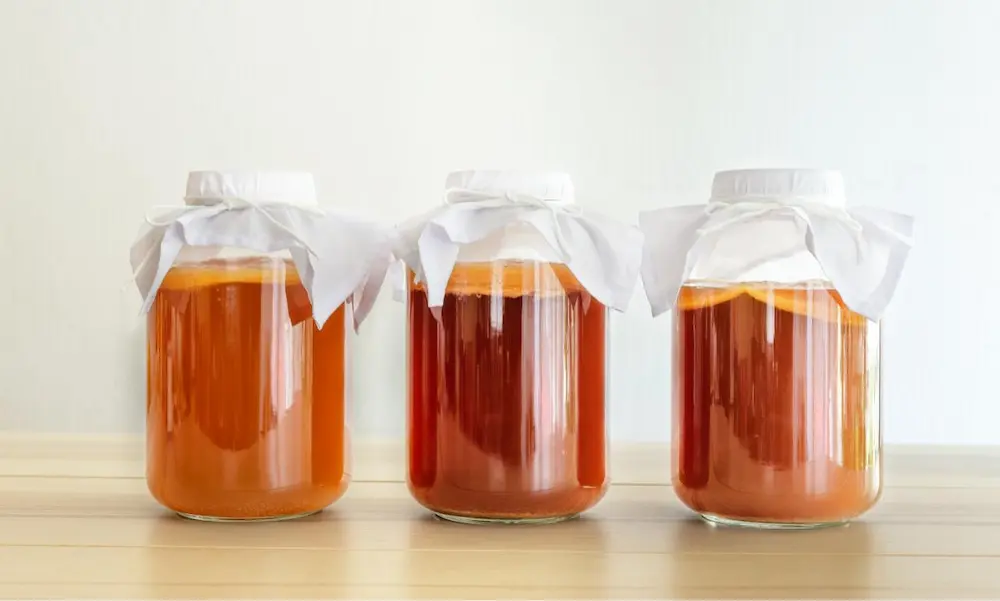
Kombucha Tea Tastes Better with Age
Though bacterial activity halts when bottled, yeast in the beverage continues to work and produce gases for some time, resulting in a perfectly effervescent drink. This process is known as maturation, lasting a minimum of three days. Afterward, kombucha tea remains good for months. Store the hermetically sealed kombucha elixir in a cool, dark place.
Consumption and Dosage of Kombucha Tea
If you followed all the instructions and guidelines during preparation, you’ve crafted a perfectly delightful magical elixir from the kombucha mushroom. The beverage boasts a pleasant taste, effervescence, mild tanginess, and refreshing qualities. It’s recommended to consume at least three 2-deciliter glasses daily: one on an empty stomach in the morning, another after lunch, and the last before bedtime. Enjoy!
If you prepare kombucha mushroom at home, you should know this
If you encounter slow growth with the young kombucha, which can be expected during colder winter conditions, don’t consider it an issue—it’s normal under those circumstances. Just give it a bit more time. Sometimes, this period can extend to 3 to 5 weeks, which passes as the mushroom sufficiently develops.
The kombucha mushroom grows and entirely covers the tea’s surface. As it progresses, it gradually thickens on the tea’s surface. The thickened culture consists of easily separable layers that can be detached from each other, and each layer can be used independently as a culture for producing kombucha tea. Hence, you can share it with someone seeking a kombucha mushroom for their starter.
Occasionally, the culture floats on the surface, while at other times, it sinks to the bottom—both scenarios are normal. When the culture sinks to the vessel’s bottom, a new culture begins forming at the top. This natural reproduction continues until it becomes dark brown. When it turns dark and murky brown, discard it and replace it with one of its offspring.
Kombucha Side Effects
Consuming kombucha is generally safe for most individuals when consumed moderately. So far, there have been no recorded instances where kombucha directly triggered or induced any disease symptoms. However, there are potential kombucha side effects some individuals might experience:
- Digestive Issues: Kombucha contains acids and may irritate the stomach in some people. Those sensitive to acidity or with stomach issues might experience discomfort, bloating, or heartburn after consuming kombucha.
- Risk of Contamination: Improper preparation of kombucha or inadequate hygiene conditions could lead to contamination of the drink with harmful bacteria or molds, resulting in health issues.
- Allergen Reactions: If kombucha contains additives like fruits, herbs, or other ingredients you’re allergic to, allergic reactions might occur.
- Drug Interactions: Some evidence suggests that kombucha might affect the absorption of drugs in the body. Therefore, if you regularly take medications, it’s advisable to consult a doctor before introducing kombucha into your diet.
- Effects on Body Acidity: There’s concern about the possibility that kombucha’s acidity might impact the body’s pH levels. Although the body can regulate pH balance, regular consumption of acidic drinks may have a certain influence.
For most people, consuming moderate amounts of kombucha won’t lead to side effects. However, if you notice any unusual reactions after consuming kombucha, which can be associated with kombucha side effects it’s advisable to stop drinking it and consult a doctor, especially if you have existing health issues or are sensitive to specific ingredients.
